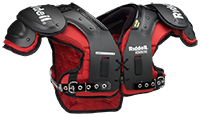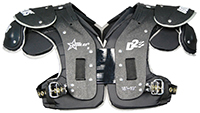Are you a beginning player or just want to learn more about all of the features of a shoulderpad? This guide wil help you to know what to watch when you're looking for a new American Football shoulder pad.
The type of shoulder pad that you are looking for is linked to a certain position. Learn for yourself which shoulder pads work best for all positions.
Lineman or fullbacks are the more defensive players. They often look for heavier padding or padding which is more protective. The skilled positions, like quarter backs, wide receivers and running back look for lighter pads which provide visibility and mobility.
Quarterback
Kickers
Most of the kickers and punters in the game use a pad that is suited for the quarterback positions. The reason behind this is that these are the lightest pads to use and give the greatest range of motion.
Skilled positions pads
Running back, wide receiver and defensive back are skilled positions. They often use extra lightweight pads that absorbs the hits without losing agility.
The low-profile design stays on the right place and doesn’t ride up during big plays. The hitting flaps are untied. This gives the player optimal arm motion while intercepting a pass or when catching a football.
All-Purpose pads
The High-impact padding protects the player against hard hits. The plated front pads give a secure feeling and locked-in fit so you won’t need to pull your pad down after every play. Also the all-purpose pads have a heavier construction compared to a QB pad. But they are still light enough to maintain agility.
Linemen pads
Linemen pads are the heaviest and toughest pads, these pads provide protection against constant and hard-hitting opponents. No shoulder straps that the opposing linemen can get a hold of. Also there is still enough mobility against the opposing line.
Belted or strapped
There are three different ways a shoulder pad can be fitted around your chest. The first way is with a strap. A strap is made from high quality leather with holes in the middle. The shoulder pad can be fitted by these holes. An other is way is with a belt. A belt is made from an elastic material. The shoulder pad will be fitted around your chest by setting the belt at the right length. The third way is with a belt and a strap. Some shoulderpads only have one of these, but other have both for maximum scured fit. These are mostly defensive pads.
Measuring the pad
Follow the steps below to measure the right sizing and fit of your pad.
Click here for the Riddell shoulder pad fitting guide.
.jpg)



